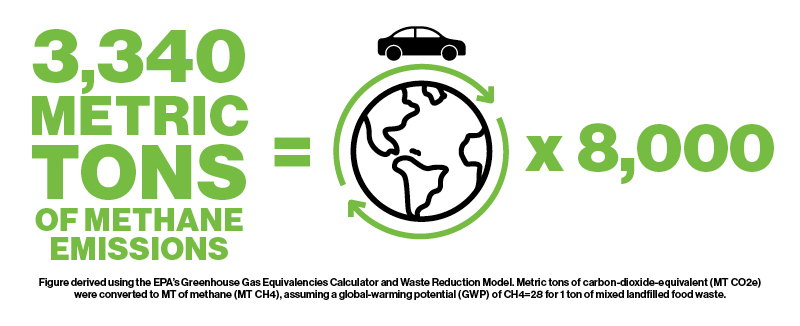Program to lift efforts to divert food waste quadruples goal, offsetting CO2e of a car circling globe 8K times
A program to tackle food waste by reimbursing community- and business-led projects across New York State exceeded its original goal by more than 400 percent, keeping 125,065 tons of food scraps and edible food out of landfills. Over six years, it provided key capital funding for many businesses, municipalities, and nonprofits as efforts to turn the tide on wasted food that continued to grow in the Empire State.
The Food Waste Reduction and Diversion Reimbursement Program—an innovative partnership between New York State and the New York State Pollution Prevention Institute (NYSP2I)—reimbursed 42 entities across the Empire State for projects to keep food out of landfills or incinerators. Launched in 2018, the program concluded last August, surpassing its original goal by more than four times over.
The program was an initiative of New York’s Empire State Development (ESD) with funding provided by New York State. NYSP2I managed the program, reviewing applications, selecting awardees, and distributing funds.
ESD and NYSP2I designed the program to address the negative impacts of wasted food, such as resource loss. Everything that goes into growing, harvesting, and transporting the 4 million tons of food that gets thrown out each year in New York goes to waste with it. Uneaten food in landfills also contributes to climate change because it releases methane, a potent greenhouse gas, when it decomposes.
Program impact—by the numbers
Final numbers:
- $2.4M: funds reimbursed
- 42: organizations that received funding
- +125K: tons of food waste diverted from landfills
- 3.34K: metric tons of methane emissions avoided
- 4+: number of times program goal was met
"Our original goal was to divert 30,100 tons of food waste," said Ava Labuzetta, the NYSP2I senior pollution prevention engineer who managed the program. "Having more than quadrupled that with a total of over 125,000 tons, I think it highlights how much is going on right now in New York State around food waste diversion. Businesses are seeing the opportunity to get involved in this space and grow and that is exactly what we need."

Over the course of six years, the program diverted enough food waste to fill 160 Statues of Liberty by volume. Recovering that much food from the waste stream avoided 3,340 tons of methane emissions, the equivalent of a single passenger vehicle driving around the world more than 8,000 times.

Easing adoption of new law
New York’s Food Donation and Food Scraps Recycling law—passed in January 2022—was created to turn the tide on how much uneaten food and food scraps ends up in landfills or is incinerated. The law requires businesses and institutions generating an average of two tons of wasted food per week or more to find a way to recycle their food scraps. (It only applies if they are within 25 miles of an organics-recycling facility with capacity to take their material.)
For many organizations, such as large institutional kitchens in hospitals or schools, the law represents a new set of skills and logistics that they may not have considered before. Similarly, the service economy and infrastructure for food recycling—which includes firms that haul organics, convert wasted food into economic value, or distribute edible food to people who need it—is still growing in New York. Initiatives like the NYSP2I reimbursement program fill important practical gaps across this ecosystem, offering organizations an incentive to invest and innovate in order to build up their capacity for addressing food waste.
“Moving to a more circular food system requires a multi-layered solution, and we’ve seen that clearly exemplified in the diversity of projects submitted to this program,” said Labuzetta. “Providing direct capital reimbursements to entities who are already doing this work has proven to be an immensely successful model.”
New Yorker-led
Businesses, nonprofits, or municipalities across New York State that produce, haul, or recycle greater than one ton of food waste per week were eligible to apply to the program. Awardees could receive up to 44 percent of capital equipment costs spent on a project to recover uneaten food from the waste stream.
In total, $2.4M was dispersed to 42 entities, including grocery store chains and food producers, organics recyclers, haulers, donation programs, and more—some even received multiple awards. To receive funding, awardees had to quantify how much food waste they were going to offset as a result of the equipment they planned to purchase. No reimbursement was awarded until that goal was met. Capital purchases ranged from basic equipment purchases, like buckets, totes, and composting setups, to more advanced technologies, like refrigeration equipment, vehicles, sensor systems, and software.
“The fact that this program exceeded our expectations shows just how important initiatives like these are for businesses in New York,” observed Nabil Nasr, NYSP2I’s interim director and the director of GIS. “The need is there and, working together through innovative partnerships like the reimbursement program, we're able to meet it.”









